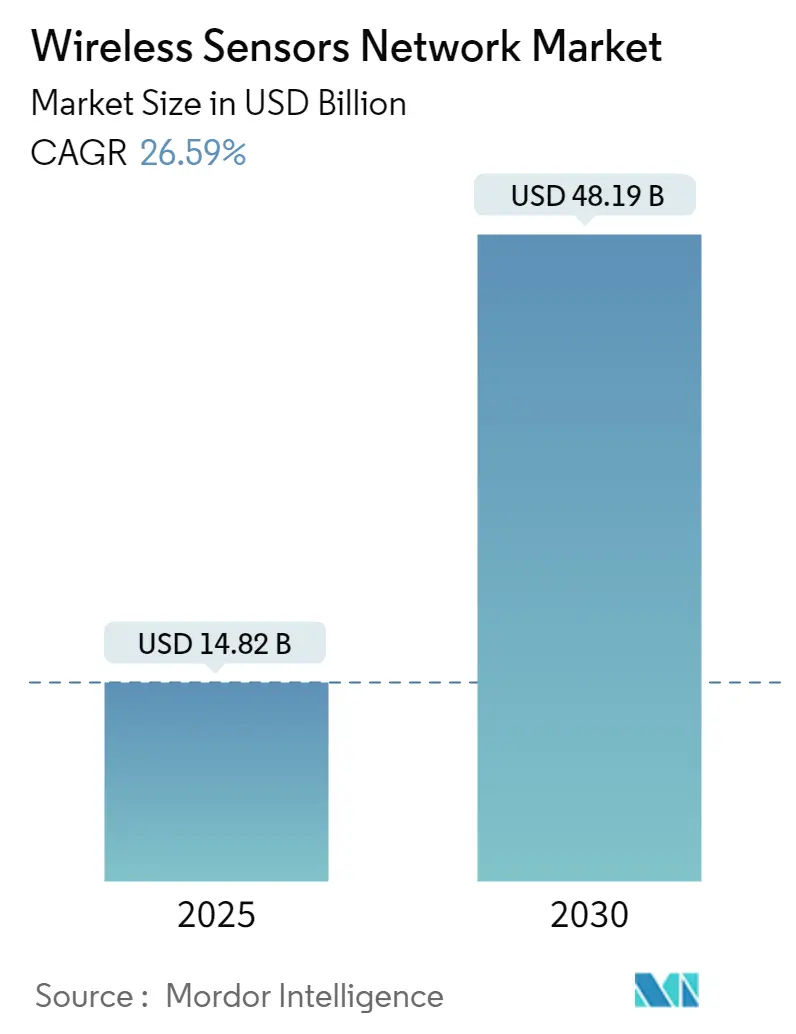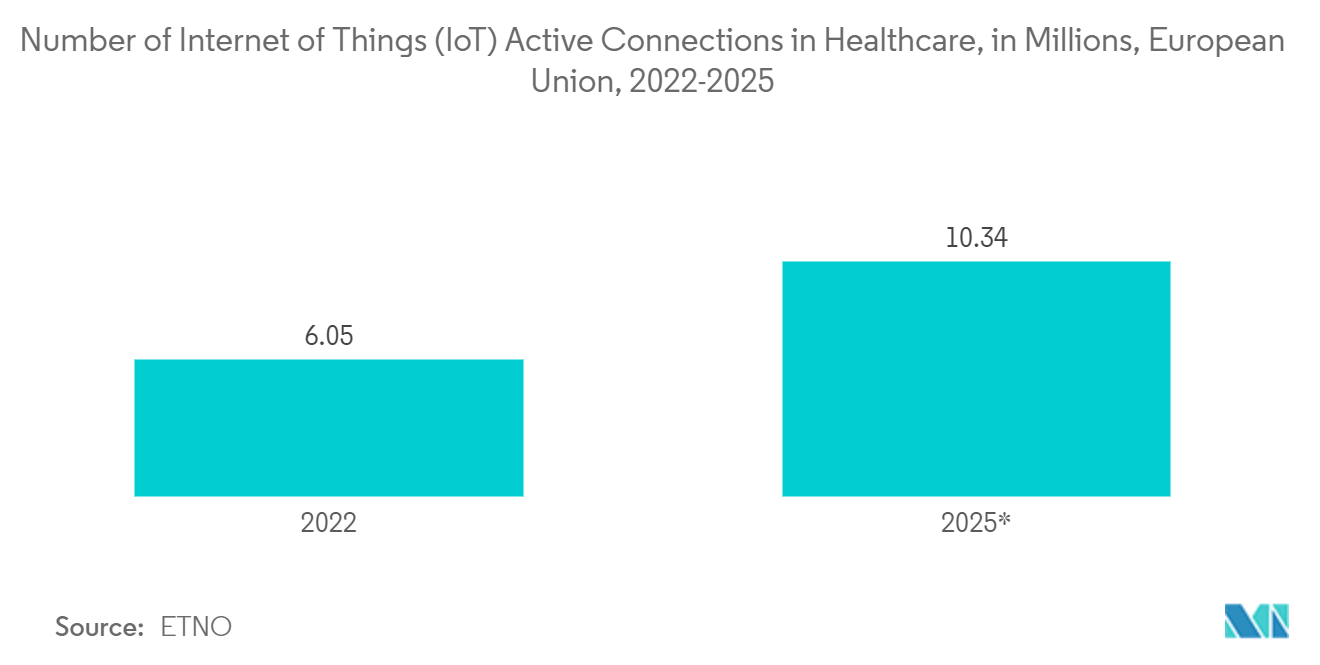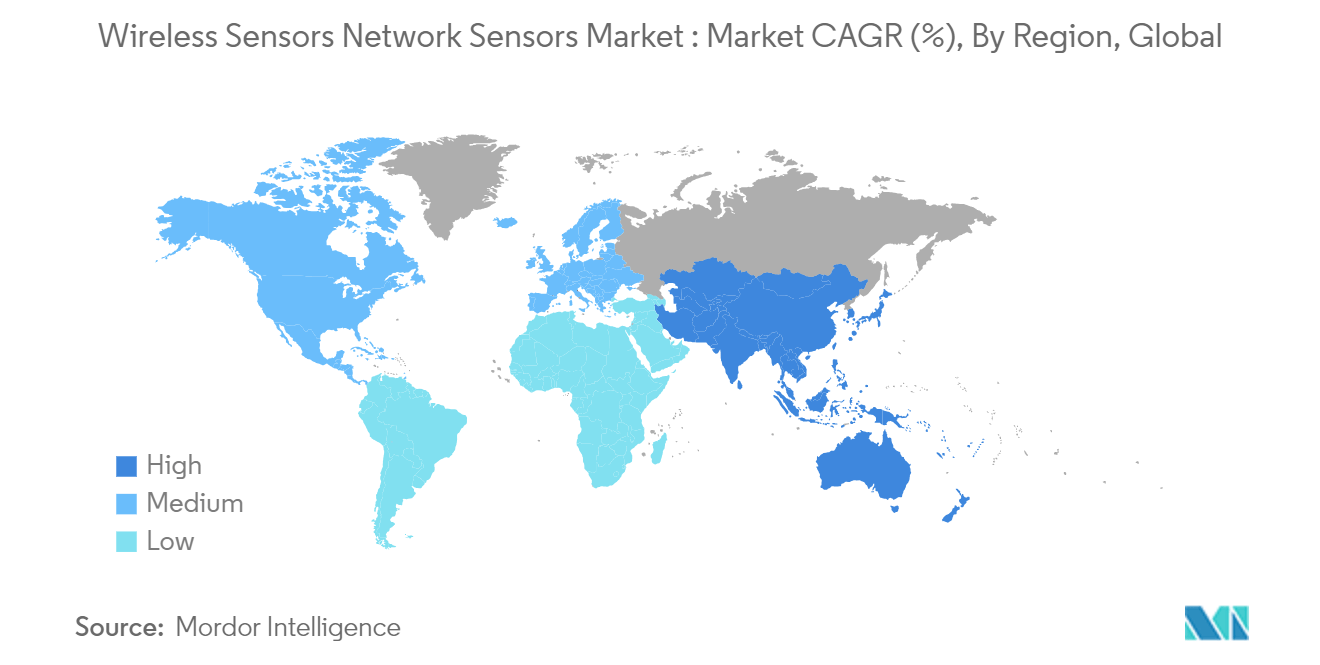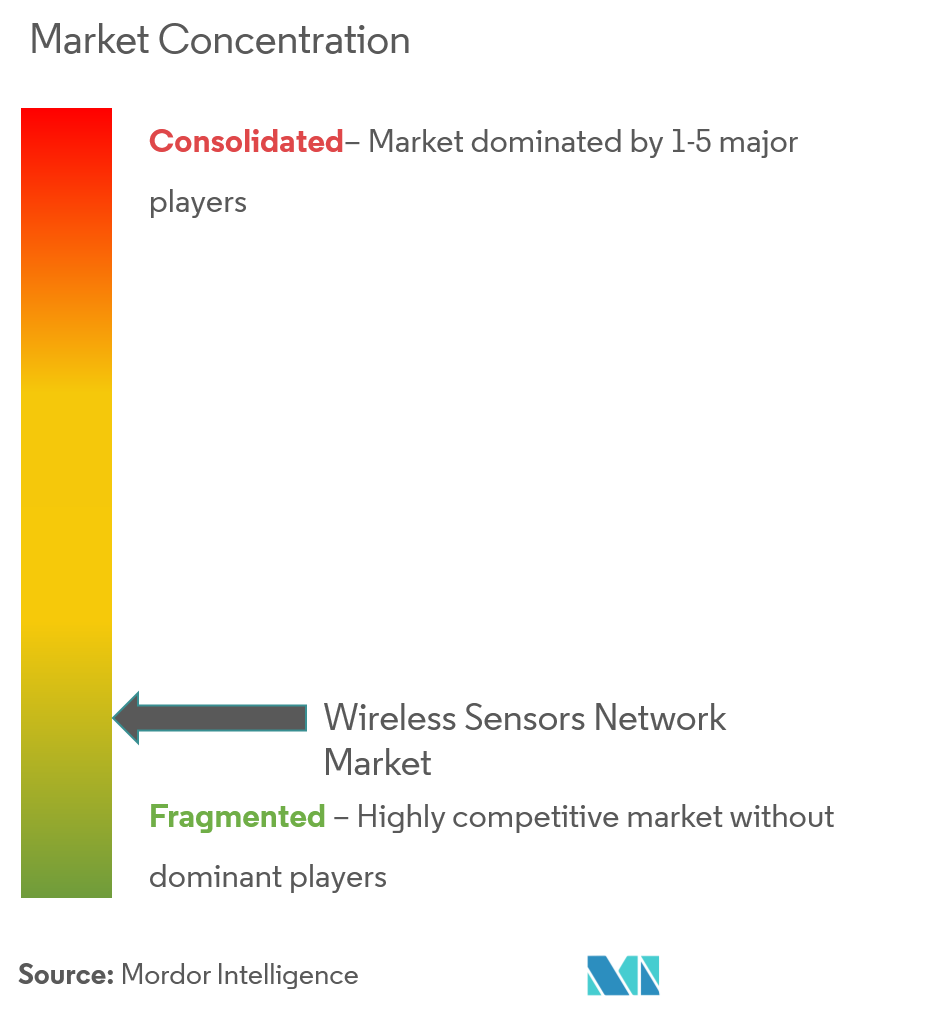Wireless Sensors Network Market Size and Share

Wireless Sensors Network Market Analysis by Mordor Intelligence
The Wireless Sensors Network Market size is estimated at USD 14.82 billion in 2025, and is expected to reach USD 48.19 billion by 2030, at a CAGR of 26.59% during the forecast period (2025-2030).
There are many applications of wireless sensor networks in robotics, such as advanced robotic sensing, multiple robot coordination, robot planning and navigation, and robot localization. Using wireless sensor networks helps emergency response robots to be conscious of conditions, such as electromagnetic field monitoring, forest fire detection, etc.
- The growing automation and robotics industry, increasing demand for a wireless sensor network in asset monitoring, security, and transportation, and improved reliability with communication technology advancements are the significant factors driving the market for wireless sensor networks (WSN).
- Owing to the increased government regulation for the increased use of sensors for safety, the demand for wireless sensors is growing, for instance, in areas with challenging environmental conditions, such as extremely high pressure and high temperature. With the help of wireless sensors, it becomes easy to control and monitor the facility from a safe distance continually. They help acquire data from locations that are difficult to access.
- The rising adoption of IoT (Internet-of-Things) is another major factor driving the market's growth. This growth in IoT-connected devices is projected to fuel the demand for wireless sensor networks.
- Sensor manufacturers heavily invest in technology to cater to emerging verticals, such as smart cities and autonomous vehicles, which are substantially dependent on wireless technologies. Innovation in sensor technologies, such as intelligent sensors, is expected to support the rapid adoption of wireless technologies in the market. All these factors are expected to contribute to the growth of the wireless sensor network market.
- Despite their highly practical usefulness, there are some challenges in using wireless sensor network systems. There are vast differences in the scale of such sensor networking systems, as the number of sensor nodes may vary from a few to several. An adjustment also follows this in the density of deployment. The software and hardware design needs to be optimized to operate effectively for the task at hand, given that wireless sensor nodes have to function on an insufficient power supply.
- WSN has several constraints like power supply, storage, and a large number of algorithms, so there is a serious challenge in the maintenance of all these. Like all internet-dependent applications, WSN also has an insecurity scare. In order to combat data thefts in all possible ways, it is necessary to implement appropriate data transmission management.
Global Wireless Sensors Network Market Trends and Insights
Medical Segment is Expected to Witness Significant Growth
- There are several issues facing the healthcare industry: soaring costs, growing incidences of medical errors, staffing shortages, aging populations, etc. Despite the challenges, healthcare professionals are under pressure to deliver improved services while at the same time adopting modern technologies. Long-term costs can be decreased, and the quality of services can be improved by offering ubiquitous healthcare. Wireless sensor networks can provide efficient solutions to an increasingly widespread healthcare system.
- Due to advances in sensors and network technologies that do not use much power, WSNs for healthcare have begun to emerge in recent years. The wireless sensor network is frequently emerging as a significant component of the next-generation healthcare system. They are a multihop Zigbee-based system that uses multicasting or broadcasting to deliver vital information. The speed and reliability of messages is an essential feature of such a system.
- They relate to the collection of real-time health information from various sensors. Wireless protocols, radio spectrum, data bandwidth, encryption, energy consumption, and mobility are essential features of these networks.
- With the development of wearable sensors, users can constantly monitor physiological data aided by wireless sensor networks in healthcare. During patient hospitalization or residence, a body area network will continue to monitor their health. This service may be helpful in emergency cases when it transfers data on patients' condition to a healthcare provider. Providing healthcare services for people, including memory enhancement, health data access, cancer detection, asthma symptoms, and blood glucose monitoring, can also be helpful.
- In addition, a new Internet of Medical Things has been set up in conjunction with telemedicine and will play an important role in the monitoring and prevention of diseases, RBSA Advisors reports. Analytics, tools, and machines driven by artificial intelligence can help healthcare providers select the right approach for each patient regarding more effective, accurate, and impactful interventions.
- In India, emerging technologies are helping the development of novel and better treatments while lowering costs. Over the next few years, artificial intelligence (AI), data, and IoMT will have swiftly expanded from simple devices that are designed to track vital signs such as heart pump rate and blood oxygen levels to smartwatches that are capable of even complex scans such as ECGs and smart textiles that can track blood pressure and also predict the risk of heart attacks.

North America Holds Largest Market Share
- North America is expected to be an important market for wireless sensor networks during the forecast period, as it is at the very early stage of adopting cutting-edge technologies like smart cities and building and industry automation. In addition, the WSN market’s growth in the region is expected to be driven by technological advances in healthcare infrastructure and increasing consumer interest in wearables.
- The adoption of smart factories, intelligent manufacturing, and the presence of many industrial wireless sensor network manufacturers are expected to drive the growth of the North American market in the coming years. The presence of several key players, such as ABB Ltd, Emerson Electric Co., and Honeywell International Inc., is also expected to prompt market growth in this region.
- Wireless sensor networks were used in health applications to provide impaired interfaces, integrated patient monitoring, diagnostics, and drug administration in hospitals, telemonitoring of human physiological data, and tracking and monitoring of doctors or patients within a hospital.
- The North American freight railroad industry is also trying to leverage WSN onboard railcars for advanced monitoring and alerting. In railroad environments, freight train WSNs exhibit a linear chain-like topology of significant length.
- Furthermore, with the increasing penetration of wearable devices in the commercial market, wearable devices are also becoming increasingly popular for industrial usage due to their numerous benefits. For instance, Airbus implemented wearable devices in the aerospace and defense industries in collaboration with Accenture.

Competitive Landscape
The wireless sensors network market is fragmented. It is a highly competitive market without any single dominant player present in the market. The players are focused on strategic investments to innovate new products, collaborations and partnerships, and mergers and acquisitions to strengthen the market position.
- November 2023: STMicroelectronics released a new microcontroller (MCU) that fuses the company’s expertise in wireless-device design with its high-performing and efficient STM32 architecture, especially valuable in remotely deployed applications, including metering and monitoring devices and data from alarm systems, actuators, and sensors in today’s smart buildings, smart factories, and smart cities.
- October 2023: NXP Semiconductors announced the launch of AW693, a new automotive-qualified wireless connectivity solution. Designed for automotive from the ground up and part of the industry’s most complete automotive wireless connectivity portfolio, AW693 enables concurrent dual Wi-Fi 6E and Bluetooth 5.3 connections, protected by NXP’s integrated EdgeLock secure subsystem, to deliver many secure connections in the car.
Wireless Sensors Network Industry Leaders
-
Siemens AG
-
ST Microelectronics
-
Emerson Electric Co.
-
NXP Semiconductors
-
ABB Ltd
- *Disclaimer: Major Players sorted in no particular order

Recent Industry Developments
- March 2024: Brown researchers developed a brain-inspired wireless system to gather data from salt-sized sensors. These sensor networks are designed so the chips can be implanted into the body or integrated into wearable devices. Each submillimeter-sized silicon sensor mimics how neurons in the brain communicate through spikes of electrical activity. The sensors detect specific events as spikes and then transmit that data wirelessly in real time using radio waves, saving both energy and bandwidth.
- March 2024: IIT-Mandi introduced a groundbreaking power management unit designed explicitly for directly cloud-enabled indoor wireless sensor network (WSN) nodes. These nodes, offering distinct advantages over low-power wireless communication technologies, often face challenges related to the consumption of higher peak current during data transmission, leading to battery capacity degradation and reduced lifespan.
Global Wireless Sensors Network Market Report Scope
A wireless sensor network (WSN) is an infrastructureless wireless network deployed in several wireless sensors, ad hocly monitoring their physical and environmental conditions. The WSN has sensor nodes connected to an onboard processor for ecological management and monitoring in a specific area. They are connected to the base station of the WSN system, where processing takes place. A base station on the WSN system has an internet connection to share data.
The wireless sensors network market is segmented by end user (military and security, medical, transportation and logistics, oil and gas, waste and wastewater, consumer packaged goods [food and beverage], and other end users) and geography (North America [United States, Canada], Europe [United Kingdom, Germany, France, Rest of Europe], Asia-Pacific [China, India, Japan, Rest of Asia-Pacific], Latin America [Brazil, Mexico, Argentina, Rest of Latin America], Middle East and Africa [United Arab Emirates, Saudi Arabia, South Africa, Rest Middle East and Africa]. The market size and forecasts are provided in terms of value (USD) for all the above segments.
| Military and Security |
| Medical |
| Transportation and Logistics |
| Oil and Gas |
| Water and Wastewater |
| Consumer Packaged Goods (Food and Beverage) |
| Other End-users |
| North America | United States |
| Canada | |
| Europe | United Kingdom |
| Germany | |
| France | |
| Asia | China |
| Japan | |
| India | |
| Australia and New Zealand | |
| Latin America | Brazil |
| Mexico | |
| Argentina | |
| Middle East and Africa | United Arab Emirates |
| Saudi Arabia | |
| South Africa |
| By End-user | Military and Security | |
| Medical | ||
| Transportation and Logistics | ||
| Oil and Gas | ||
| Water and Wastewater | ||
| Consumer Packaged Goods (Food and Beverage) | ||
| Other End-users | ||
| By Geography*** | North America | United States |
| Canada | ||
| Europe | United Kingdom | |
| Germany | ||
| France | ||
| Asia | China | |
| Japan | ||
| India | ||
| Australia and New Zealand | ||
| Latin America | Brazil | |
| Mexico | ||
| Argentina | ||
| Middle East and Africa | United Arab Emirates | |
| Saudi Arabia | ||
| South Africa | ||
Key Questions Answered in the Report
How big is the Wireless Sensors Network Market?
The Wireless Sensors Network Market size is expected to reach USD 14.82 billion in 2025 and grow at a CAGR of 26.59% to reach USD 48.19 billion by 2030.
What is the current Wireless Sensors Network Market size?
In 2025, the Wireless Sensors Network Market size is expected to reach USD 14.82 billion.
Who are the key players in Wireless Sensors Network Market?
Siemens AG, ST Microelectronics, Emerson Electric Co., NXP Semiconductors and ABB Ltd are the major companies operating in the Wireless Sensors Network Market.
Which is the fastest growing region in Wireless Sensors Network Market?
Asia Pacific is estimated to grow at the highest CAGR over the forecast period (2025-2030).
Which region has the biggest share in Wireless Sensors Network Market?
In 2025, the North America accounts for the largest market share in Wireless Sensors Network Market.
What years does this Wireless Sensors Network Market cover, and what was the market size in 2024?
In 2024, the Wireless Sensors Network Market size was estimated at USD 10.88 billion. The report covers the Wireless Sensors Network Market historical market size for years: 2019, 2020, 2021, 2022, 2023 and 2024. The report also forecasts the Wireless Sensors Network Market size for years: 2025, 2026, 2027, 2028, 2029 and 2030.
Page last updated on:
Wireless Sensors Network Market Report
Statistics for the 2025 Wireless Sensors Network market share, size and revenue growth rate, created by Mordor Intelligence™ Industry Reports. Wireless Sensors Network analysis includes a market forecast outlook for 2025 to 2030 and historical overview. Get a sample of this industry analysis as a free report PDF download.



